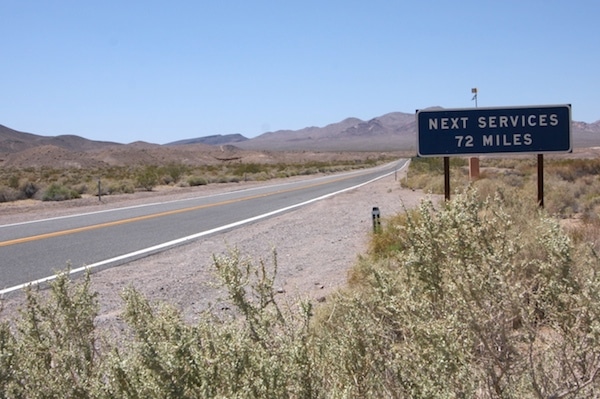This post is part of Just Ahead’s Death Valley Trip Planner—our guide to everything you need to know to plan your trip to Death Valley National Park. Click here to see the complete series, and be sure to download our Just Ahead smartphone audio tour of Death Valley before you head to the park.
Death Valley National Park is a remote desert and mountain park, and the largest park in the lower 48 American states. It’s smart to be prepared for a trip to Death Valley—that is, to come with your vehicle in excellent working order and with food and water on board. The park does have excellent services, including three gas stations and stores. But you’ll be far from those services much of the time. Here are some issues you should prepare for:
Dehydration
Death Valley is the driest place in North America. Even when the temperature is pleasant, even when you’re standing still, the air constantly saps moisture from your body. So dehydration is a year-round concern. The solution is simple, of course—carry and drink plenty of water. Drink regularly, even if you’re not thirsty. You’ll need at least a gallon per person per day—twice that if you’re hiking or biking. Carry water with you whenever you leave the car—I like to use a Camelbak or similar hydration system so that my source of water is just inches away.
Weather
The main weather concern you should prepare for in Death Valley is, of course, heat. But much of the year it can be cool to chilly in the park at night. Wind is likely anytime. Winter rains and occasional summer thunderstorms can wash out roads. So keep an eye on the weather by way of a website like weather.com, and check the park’s homepage—or if you’re in the park, the visitor center—for weather alerts and road closures. Remember too that Death Valley has mountains where it can be 40 degrees cooler than the desert floor, and where you might encounter snow in winter and spring. By the way, we share some great stories about the weather in the Just Ahead tour of Death Valley. And we’re not averse to a summer visit, even though it’s a bit warm then. Click here for 10 reasons to visit Death Valley in summer.
Lack of Mobile Phone and Internet Coverage
Don’t count on making mobile phone calls in Death Valley. You might get a weak signal in Furnace Creek, but it’s not likely, and you won’t find reception anywhere else in the park. Furnace Creek does have conventional pay phones. As for the Internet, you can generally hop on wi-fi at Furnace Creek Ranch and Furnace Creek Inn, and much of the time at the Furnace Creek Visitor Center. Remember that the Just Ahead app does not require an Internet connection or a mobile phone signal. We’re with you every step of the way!
Distance Between Services
You’ll find gas, basic groceries, ice, and sit-down meals at Furnace Creek, Stovepipe Wells, and Panamint Springs, but remember, Death Valley is huge—3.4 million acres—and you’re likely to be many miles from these services during your tour of the park. Gas in the park is expensive, but running out is far worse than paying high prices. Start your day with a full tank and all the food and water (at least a gallon per person per day) you might need. If your car should happen to break down, stay with it. Rangers patrol the park. It’s much smarter to wait than to set out on foot.
Desert Sun
The desert sun is powerful anytime. A broad-brimmed hat, protective clothing, sunscreen, and sunglasses are always in order in Death Valley.
Vehicle Cautions
Be sure your car is in excellent working order, particularly its cooling system and tires. Be realistic about your car’s ability to travel dirt roads. Just Ahead primarily sticks to paved roads and short, graded dirt roads that are generally suitable for passenger vehicles. We tell you when high clearance might be in order. If you’re renting, it’s a good idea to rent a four-wheel drive vehicle or one with high clearance. That way you’ll have no concerns traveling the graded dirt roads we suggest. Death Valley has a huge network (785 miles) of remote dirt roads that are quite rough and require a high-clearance vehicle, if not four-wheel drive. Only set off on those roads if you’re experienced and fully prepared for backcountry travel. If you get to the park in a passenger car and find yourself intrigued by its backcountry roads (Titus Canyon or the Racetrack, for example) visit Farabee’s Jeep Rentals across the street from Furnace Creek Inn. They rent sturdy 4x4s and offer guided off-road tours.
Death Valley Packing Checklist
We use this basic checklist as a starting point for our trips to Death Valley National Park. Obviously, if we’re camping, this list expands, and winter requires extra clothing.
- Water—at least one gallon per person per day
- Food—more than you think you’ll need
- Ice and ice chest
- Sun hat and sunscreen
- Sunglasses
- Layers of light clothing
- Sturdy footwear
- Daypack or Camelbak
- First aid kit
- Hand purifier
- Pocketknife
- Smartphone or tablet (loaded with Just Ahead, of course)
- Cords to charge smartphone or tablet in car
- Camera
- Binoculars
- Notebook
- Flashlight or headlamp
For our complete Death Valley Trip Planner series, click here.
